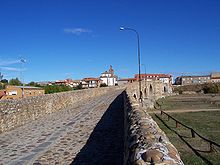Suero de Quiñones: Difference between revisions
12 Centuries (talk | contribs) Correcting major factual uncited errors and editing for content flow |
{{accuracy}}: and why should we trust a 1930 edition over Riquer, from 1967? |
||
| Line 1: | Line 1: | ||
{{accuracy}} |
|||
[[Image:Puentepaso honroso1 lou.jpg|thumb|The bridge over the Órbigo and the field of battle to its right]] |
[[Image:Puentepaso honroso1 lou.jpg|thumb|The bridge over the Órbigo and the field of battle to its right]] |
||
'''Suero de Quiñones''' (c. 1409 – c. 1458), called ''el del Passo'', was a [[Kingdom of León|Leonese]] knight and author. He gained fame by staging a ''[[pas d'armes]]'', the ''[[Passo Honroso]]'', at the river [[Órbigo]] and describing it in his ''[[Libro del Passo honroso]]''. |
'''Suero de Quiñones''' (c. 1409 – c. 1458), called ''el del Passo'', was a [[Kingdom of León|Leonese]] knight and author. He gained fame by staging a ''[[pas d'armes]]'', the ''[[Passo Honroso]]'', at the river [[Órbigo]] and describing it in his ''[[Libro del Passo honroso]]''. |
||
| Line 6: | Line 7: | ||
From 10 July to 9 August 1434 at the [[Órbigo bridge]] in [[Castile (historical region)|Castile]], Suero and ten of his companions encamped in a field beside the bridge and challenged each knight who wished to cross it to a [[joust]]. This road was used by pilgrims all over Europe on the way to shrine at [[Santiago de Compostela]], and at this time of the summer, many thousands would cross the bridge. Suero and his men swore to "break 300 [[lance]]s" before moving on. |
From 10 July to 9 August 1434 at the [[Órbigo bridge]] in [[Castile (historical region)|Castile]], Suero and ten of his companions encamped in a field beside the bridge and challenged each knight who wished to cross it to a [[joust]]. This road was used by pilgrims all over Europe on the way to shrine at [[Santiago de Compostela]], and at this time of the summer, many thousands would cross the bridge. Suero and his men swore to "break 300 [[lance]]s" before moving on. |
||
They men fought for over a month, an account of which is left to us in great detail by town notary Don Luis Alonso Luengo who kept a detailed first-hand chronicle (latter published as ''Libro del Passo honroso''<ref>Pedro Rodríguez de Lena (1930), ''[http://books.google.com/books?vid=LCCN31009612&id=NdzaIrbOJPsC&q=The+Passo+Honroso&dq=The+Passo+Honroso&pgis=1 A Critical Annotated Edition of El Passo Honroso de Suero de Quiñones]'', 1977 edition ISBN 8473920104</ref>). After 166 battles Suero and his men were so injured they could not continue and declared the mission complete. Suero de Quiñones became legendary in Spanish history and was mentioned in [[Don Quixote]], the 1605 |
They men fought for over a month, an account of which is left to us in great detail by town notary Don Luis Alonso Luengo who kept a detailed first-hand chronicle (latter published as ''Libro del Passo honroso''<ref>Pedro Rodríguez de Lena (1930), ''[http://books.google.com/books?vid=LCCN31009612&id=NdzaIrbOJPsC&q=The+Passo+Honroso&dq=The+Passo+Honroso&pgis=1 A Critical Annotated Edition of El Passo Honroso de Suero de Quiñones]'', 1977 edition ISBN 8473920104</ref>). After 166 battles Suero and his men were so injured they could not continue and declared the mission complete. Suero de Quiñones became legendary in Spanish history and was mentioned in ''[[Don Quixote]]'', the 1605 satire on the sort of romantic chivalry out of touch with reality. |
||
| ⚫ | |||
== |
==Notees== |
||
{{reflist}} |
{{reflist}} |
||
| ⚫ | |||
*[[Martín de Riquer|Riquer, Martín de]] (1967). ''Caballeros andantes españoles''. Madrid: Editorial Espasa-Calpe. |
*[[Martín de Riquer|Riquer, Martín de]] (1967). ''Caballeros andantes españoles''. Madrid: Editorial Espasa-Calpe. |
||
Revision as of 22:21, 30 March 2010
This article's factual accuracy is disputed. |

Suero de Quiñones (c. 1409 – c. 1458), called el del Passo, was a Leonese knight and author. He gained fame by staging a pas d'armes, the Passo Honroso, at the river Órbigo and describing it in his Libro del Passo honroso.
Suero was the son of Diego Fernández de Quiñones, called el Afortunado, who was beneficed by his uncle Pedro Suárez and named sole heir of his possessions. Diego married María de Toledo, who bore him ten children, Suero being the second. Suero fasted in honour of the Virgin Mary every Tuesday, wore an iron necklet every Thursday as a sign of devotion to his lady, and heard Mass daily.
From 10 July to 9 August 1434 at the Órbigo bridge in Castile, Suero and ten of his companions encamped in a field beside the bridge and challenged each knight who wished to cross it to a joust. This road was used by pilgrims all over Europe on the way to shrine at Santiago de Compostela, and at this time of the summer, many thousands would cross the bridge. Suero and his men swore to "break 300 lances" before moving on.
They men fought for over a month, an account of which is left to us in great detail by town notary Don Luis Alonso Luengo who kept a detailed first-hand chronicle (latter published as Libro del Passo honroso[1]). After 166 battles Suero and his men were so injured they could not continue and declared the mission complete. Suero de Quiñones became legendary in Spanish history and was mentioned in Don Quixote, the 1605 satire on the sort of romantic chivalry out of touch with reality.
Notees
- ^ Pedro Rodríguez de Lena (1930), A Critical Annotated Edition of El Passo Honroso de Suero de Quiñones, 1977 edition ISBN 8473920104
References
- Riquer, Martín de (1967). Caballeros andantes españoles. Madrid: Editorial Espasa-Calpe.
